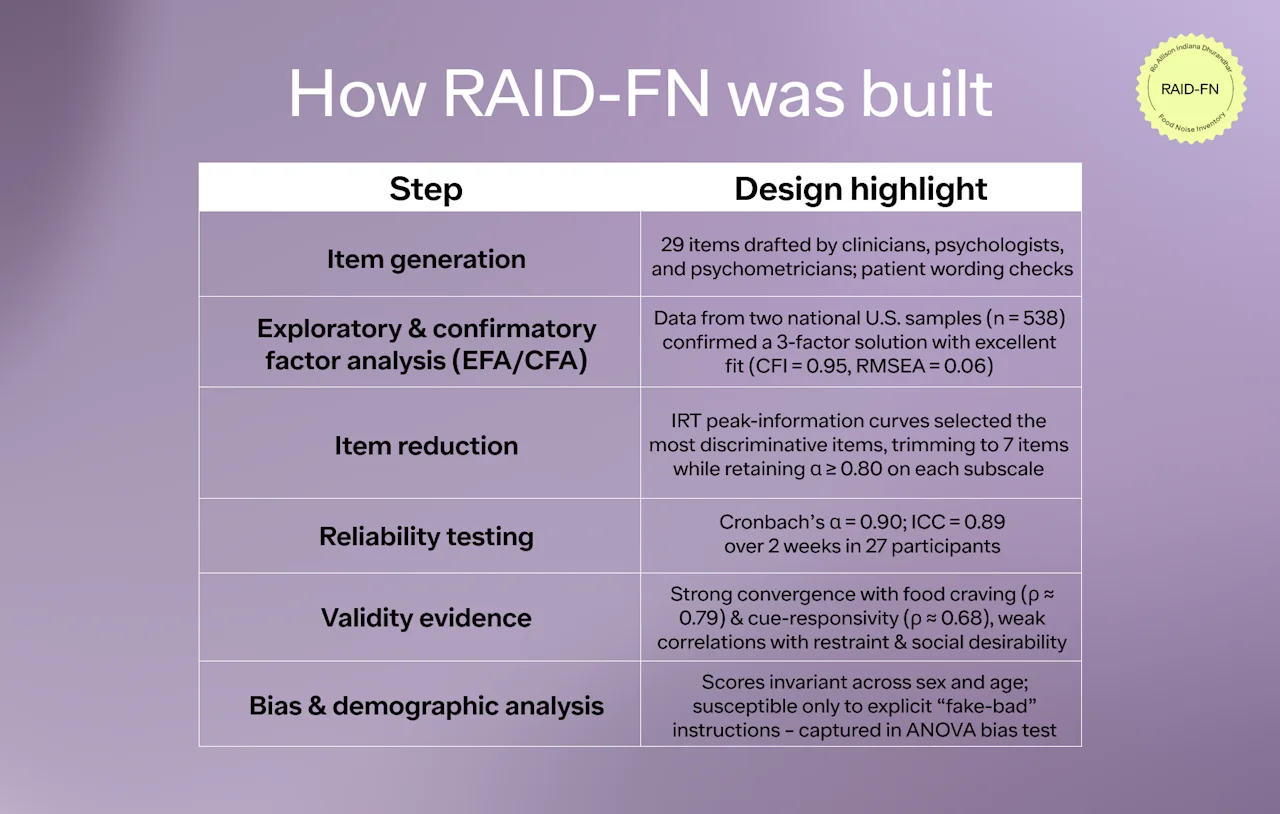Here's what we'll cover
Here's what we'll cover
Here's what we'll cover
TL;DR
The Ro Allison Indiana Dhurandhar Food Noise Inventory (RAID-FN) is a new psychometric breakthrough for measuring food noise. Here’s what you need to know:
It’s quick and precise: Just 7 questions, under 2 minutes, yet highly reliable (α = 0.90; ICC = 0.89).
It measures three key dimensions:s: Preoccupation, Persistence, and Dysphoria—capturing the mental and emotional burden of “food noise”.
Ready for real-world and research: Works consistently across age and gender, unaffected by social-desirability bias, and ready for use in both research and clinical care.
What Is Food Noise?
In the era of GLP-1 receptor agonists and emerging obesity therapeutics, a recurring theme is patient reports about a welcome, if unexpected, disruption to their constant mental soundtrack about food. The concept gained prominence and the moniker of “food noise” as patients independently but consistently described the sudden quieting of that internal chatter. For some, it was reportedly the first time in years that their thoughts were not dominated by food. This raised critical scientific questions: What is food noise, and how can it be measured?
Introducing the RAID-FN Scale
Psychology already offers numerous tools for measuring related, but distinct phenomena – food cravings, food cue reactivity, food preoccupation, and even food addiction. Yet none capture food noise as patients experience it: persistent, unwanted, and dysphoric (unpleasant) thoughts about food.
The Ro Allison Indiana Dhurandhar Food Noise Inventory (RAID-FN) was developed to fill that gap; the first psychometrically rigorous instrument designed to quantify food noise and distinguish it from overlapping constructs.
How RAID-FN Was Built and Tested
In a years-long collaboration supported by Ro, the RAID-FN scale was developed by a multidisciplinary group of researchers and clinicians with expertise spanning nutrition to psychology and obesity medicine to psychometrics. The team, led by David B. Allison, PhD and Emily Dhurandar, PhD, set out to create a questionnaire to identify and quantify the food noise that an individual experiences. They began with 29 potential questions, and through four large online studies with nationally representative samples of U.S. adults, they systematically refined and validated the scale. This work is detailed in an article in Nutrition & Diabetes, which lays out the scientific basis for their definition of food noise and the scale, as well as a multi-phase validation study published in Appetite.
Item Identification and Factor Analysis
The researcher team’s validation process produced a 23-item long form and 7-item short form questionnaire. Factor analysis, a method for uncovering underlying dimensions, showed that food noise isn’t one-dimensional. Instead, it reflects three interrelated but distinct components, known as factors:
Preoccupation: Constant thoughts about food, even when you’re not hungry.
Persistence: Trouble shutting those thoughts off once they start.
Dysphoria: The frustration, guilt, or distress that can come with them.
Reliability and Validity
Psychometric scales need to demonstrate two things: that they’re reliable (they measure something consistently) and valid (they’re measuring what they claim to). RAID-FN checks both boxes.
Internal consistency: The items work together cohesively (Cronbach’s alpha = 0.90)
Test–retest reliability: Food noise scores are stable across time (Correlation = 0.89 over two weeks).
Construct validity: The three-factor model was the best statistical fit showing that it accurately represents food noise (CFI = .95, RMSEA = .06)
Convergent validity: Strong correlations with related concepts like food cravings (r ≈ 0.78) and food cue responsivity (r ≈ 0.67), but not so much that it’s measuring the same constructsDiscriminant validity: Minimal correlation with social desirability (ρ = -0.31) or dietary restraint (ρ = 0.18), showing that the scale is capturing something distinct.
Item Response Theory (IRT) Analysis
RAID-FN performed best among individuals experiencing above average food noise (i.e., with higher scores), making it particularly effective for the group most relevant for clinical studies and treatment trials. This was tested using the Item Response Theory (IRT), a statistical framework that evaluates how well each item measures across the spectrum of severity.
Validating RAID-FN in a Weight Management Treatment-Seeking Population
Outside of the research setting, Ro added RAID-FN to the intake process for patients seeking GLP-1 treatment for weight management on our platform.
Using data from a random sample of 35,000 patients, the findings hold up:
Internal consistency: α = 0.95, even stronger than in the general population.
Item-total correlations ranged from 0.74–0.88: 0.74–0.88, showing every question meaningfully contributes to the overall score.

Why It Matters
“Food noise” started as a patient-reported experience. Now, thanks to RAID-FN, we can measure it, study it, and, hopefully, discover new ways of managing or treating it. This opens the door to answering key questions:
How common is food noise across different populations?
How does it relate to obesity, eating disorders, or quality of life?
Do interventions, whether behavioral, pharmacological, or digital, quiet food noise in measurable ways?
The RAID-FN condenses a complex, emerging construct—food noise—into a short and simple tool without sacrificing psychometric integrity. For pharma, it promises a sensitive, patient-centred endpoint perfectly timed for the next wave of anti-obesity and metabolic therapies. For academics, it unlocks new lines of inquiry at the intersection of cognition, emotion, health outcomes, and nutrition.
With a precise means of measurement, RAID-FN may ultimately help patients finally understand both the noise they experience and how to ‘turn down the volume’.